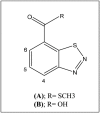Effect of Benzothiadiazole on the Metabolome of Tomato Plants Infected by Citrus Exocortis Viroid
- PMID: 31091764
- PMCID: PMC6563216
- DOI: 10.3390/v11050437
Effect of Benzothiadiazole on the Metabolome of Tomato Plants Infected by Citrus Exocortis Viroid
Abstract
Benzothiadiazole (BTH) is a functional analogue of the phytohormone salycilic acid (SA) involved in the plant immune response. NahG tomato plants are unable to accumulate SA, which makes them hypersusceptible to several pathogens. Treatments with BTH increase the resistance to bacterial, fungal, viroid, or viral infections. In this study, metabolic alterations in BTH-treated Money Maker and NahG tomato plants infected by citrus exocortis viroid (CEVd) were investigated by nuclear magnetic resonance spectroscopy. Using multivariate data analysis, we have identified defence metabolites induced after viroid infection and BTH-treatment. Glycosylated phenolic compounds include gentisic and ferulic acid accumulated in CEVd-infected tomato plants, as well as phenylalanine, tyrosine, aspartate, glutamate, and asparagine. Besides, an increase of γ-aminobutyric acid (GABA), glutamine, adenosine, and trigonelline, contributed to a clear discrimination between the metabolome of BTH-treated tomato leaves and their corresponding controls. Among them, GABA was the only metabolite significantly accumulated in both genotypes after the chemical treatment. In view of these results, the addition of GABA was performed on tomato plants infected by CEVd, and a reversion of the NahG hypersusceptibility to CEVd was observed, indicating that GABA could regulate the resistance to CEVd induced by BTH.
Keywords: BTH; GABA; NMR; NahG plants; defence; metabolomics; tomato; viroid.
Conflict of interest statement
The authors declare no conflict of interest.
Figures








References
-
- Bellés J.M., Garro R., Fayos J., Navarro P., Primo J., Conejero V. Gentisic acid as a pathogen-inducible signal, additional to salicylic acid for activation of plant defenses in tomato. Mol. Plant-Microbe Interact. 1999;12:227–235. doi: 10.1094/MPMI.1999.12.3.227. - DOI

